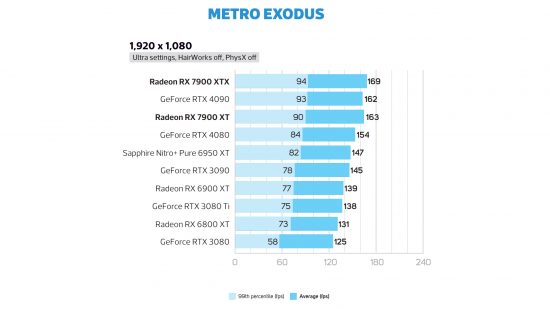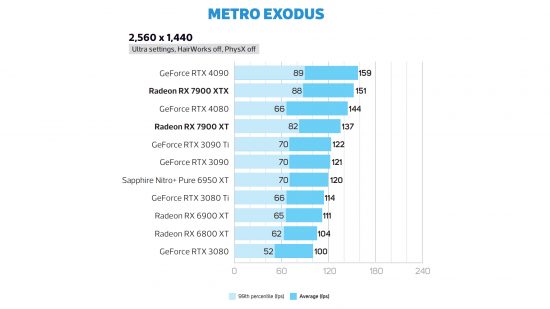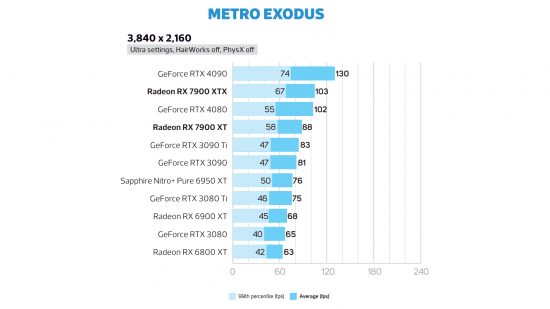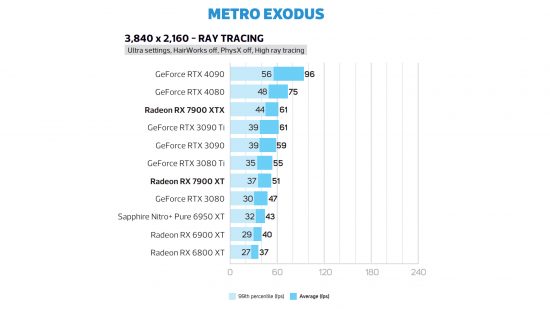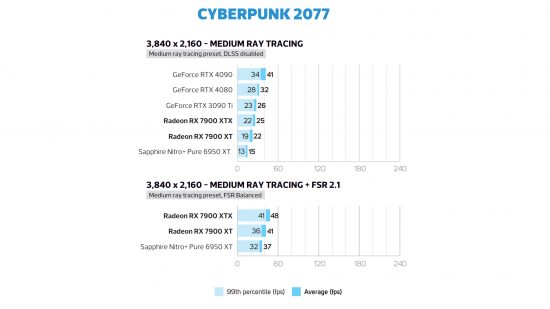Our Verdict
76%Great shader power for the money, and while Nvidia’s Ada GPUs are faster at ray tracing, the new Radeon is on par with the RTX 3090 Ti.
AMD’s latest flagship Radeon GPU is finally here, and while the Radeon RX 7900 XTX is still overpriced at $999 (£999), it looks like a veritable bargain next to the Nvidia GeForce RTX 4090 and 4080.
At Custom PC, we’ve been reviewing the latest gaming GPUs since 2003, and we run a number of grueling benchmarks in order to gauge performance. Our game tests include measuring the frame rate in Cyberpunk 2077, Doom Eternal, and Metro Exodus, all with and without ray tracing, and we also test with Assassin’s Creed Valhalla.
The new Radeon RX 7900 XTX is based on AMD’s new RDNA 3 architecture, which sees AMD make its first move to a modular, chiplet-based approach to GPU package design. Instead of having the whole lot in one monolithic die under the heatspreader, AMD has separated the L3 cache and memory controller from the main processing units, dividing them into chiplets.
Both the Radeon RX 7900 XTX and the 7900 XT are based on the Navi 31 GPU, which in the case of the 7900 XTX gives you 96 AMD Compute Units, giving you a total of 6,144 dual-issue stream processors, and each Compute Unit gives you a 2nd-generation AMD RT core as well.
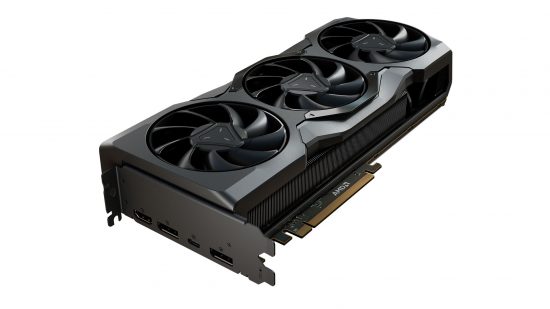
You also get 96MB of L3 cache in the Memory Cache Dies (MCD) surrounding the main GPU, called the Graphics Compute Die (GCD). This arrangement gives the Radeon RX 7900 XTX a wide 384-bit memory interface which, when combined with the 24GB of 2500MHz (20GHz effective) GDDR6 memory, gives you a total memory bandwidth of 960GB/sec – not far off the 1TB/sec+ figures we’ve seen from Nvidia’s top-end GPUs.
As a point of comparison, the top-end RDNA 2 GPU, the Radeon RX 6950 XT, had 5,120 stream processors and a 256-bit memory interface which, when combined with its 16GB of 2250MHz (18GHz effective) GDDR6 memory, gave it a total memory bandwidth of 576GB/sec. However, the Radeon RX 69550 XT did have 32MB more L3 cache.
Clock speeds have also increased over RDNA 2. The Radeon RX 6950 XT had a quoted game clock of 2100MHz and a boost clock of 2310MHz, but the Radeon RX 7900 XTX raises those figures to 2269MHz and 2499MHz respectively. These quoted figures are also quite conservative – we saw the Radeon RX 7900 XTX hit a peak boost clock of 3106MHz in our game tests, and it was consistently running at over 3GHz.
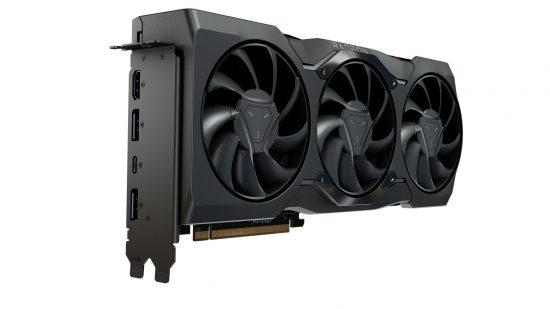
The AMD-made card we tested for this review also has a much more elegant design than Nvidia’s latest Founders Edition cards. It sticks with the tried-and-tested 8-pin PCIe power connectors, avoiding potential for melting power sockets, while also providing wide compatibility with existing PSUs. It also only takes up two (and a bit) expansion slots.
Irritating fan noise was never an issue during testing, and our sample hit a peak GPU temperature of 62°C with a peak hot spot reading of 89°C. The latter is pretty toasty, and the backplate became hot to touch, but we didn’t observe any throttling.
RX 7900 XTX performance
With a revised GPU architecture, more and faster memory and a greater number of stream processors, the Radeon RX 7900 XTX should be significantly quicker than its predecessor, and this is fully borne out in our test results. Not only that, but the 7900 XTX is also quicker than Nvidia’s pricier GeForce RTX 4080 in some tests.
In fact, it even beats the RTX 4090 in some games at 1,920 x 1,080. However, you don’t spend a grand on a GPU to run games at 1080p, so we’re going to focus on performance at 4K and 2,560 x 1,440.
Assassin’s Creed Valhalla RX 7900 XTX frame rate
Even at 4K, there’s one game where the Radeon RX 7900 XTX outperforms the Nvidia GeForce RTX 4090, which is Assassin’s Creed Valhalla. The two GPUs perform similarly in this game at 4K, and the Radeon RX 7900 XTX’s 99th percentile frame rate of 79fps and average frame rate of 106fps average are superb.
Metro Exodus RX 7900 XTX frame rate
Metro Exodus is also a strong title for the Radeon RX 7900 XTX. The RTX 4090 is in front, but that’s to be expected from a card that costs upwards of $1699 / £1699. With no ray tracing enabled, the 7900 XTX remains ahead of the RTX 4080 here, though – the averages are similar, but the Radeon has a substantially higher 99th percentile figure.
However, the two cards swap places once you add ray tracing. AMD has clearly done a lot of work on improving its ray tracing performance, but Nvidia’s latest GPUs have the upper hand. That said, the Radeon’s average of 61fps in this game at 4K with ray tracing is still a cracking result, and its 99th percentile figure of 44fps is well ahead of the 39fps from the GeForce RTX 3090 Ti, Nvidia’s former flagship.
Cyberpunk 2077 RX 7900 XTX frame rate
The situation in Cyberpunk 2077 was similar, with the Radeon RX 7900 XTX’s frame rate out-performing the GeForce RTX 4080 at the standard Ultra preset with an average frame rate of 62fps. However, the Radeon dropped behind once ray tracing was enabled. To be fair, not even the RTX 4090 can play this game at 4K smoothly with ray tracing unless you enable DLSS, but the Radeon RX 7900 XTX again performed similarly to the RTX 3090 Ti.
Not even enabling FSR 2.1 can make this game smoothly playable at 4K with Medium ray tracing on the Radeon RX 7900 XTX, with a 48fps average frame rate and 41fps 99th percentile result. Comparatively, the RTX 4090 frame rate averages 68fps at the same preset with DLSS enabled, and the RTX 4080 hits 57fps.
The Nvidia cards also have the added bonus of AI frame generation via DLSS 3, which massively improves the frame rate with ray tracing, even if it doesn’t always look perfect. AMD has clearly worked hard on its silicon with this generation of GPUs, but there’s none of the ground-breaking software innovation we saw with DLSS 3 on show here.
Doom Eternal RX 7900 XTX frame rate
When it comes to high frame rates, in Doom Eternal, the Radeon RX 7900 XTX was behind both the new Nvidia GPUs, buts its frame rate was still superb, averaging a massive 308fps at 4K, and still maintaining a 167fps average with ray tracing enabled.
RX 7900 XTX power draw
Finally, we come to power draw, where the Radeon RX 7900 XTX couldn’t be described as frugal, but is much more efficient than the last-gen GeForce RTX 3090 Ti, and our system also didn’t spike into the 600W range when running at 4K, which we saw with the GeForce RTX 4090. Our system drew a peak of 546W with the Radeon RX 7900 XTX installed.

RX 7900 XTX pros and cons
Pros
- Cheaper than RTX 4080
- Improved ray tracing performance
- Strong shader performance
- Standard power connectors
Cons
- Severely limited stock
- No AI frame generation tech
- Still expensive
- Nvidia is still faster at ray tracing
Radeon RX 7900 XTX specs
The Radeon RX 7900 XTX specs list is:
| Stream processors | 6,144 dual-issue |
| RT cores | 96 |
| ROPs | 192 |
| Game clock | 2269 MHz |
| Max boost clock | 2499 MHz |
| Memory | 24GB GDDR6 |
| Memory clock | 2500 MHz (20 GHz effective) |
| Memory bandwidth | 960 GB/s |
| Memory interface | 384-bit |
| L3 cache | 96 MB |
| Card interface | 16x PCIe 4 |
| Power connectors | 2 x 8-pin |
| Card length | 287 mm |
| Expansion slots | 2.5 |
RX 7900 XTX price
With a price of the AMD Radeon RX 7900 XTX is $999 (£999), making this a very expensive card, but it’s still far cheaper than the Nvidia GeForce RTX 4080 and 4090.
Price: Expect to pay $999 (£999)
RX 7900 XTX review conclusion
With a price of $999 (£999), AMD has cut out an attractive market slot for the Radeon RX 7900 XTX. Its raw shader power is right up there with much pricier Nvidia GPUs, and its ray tracing power is on par with the GeForce RTX 3090 Ti.
AMD still can’t catch Nvidia’s latest GPU tech when it comes to ray tracing, and it’s a shame there are no big software innovations such as DLSS 3, but the Radeon RX 7900 XTX has power where it counts. Let’s hope more stock appears in the new year and that the price eventually sticks. If you’re looking for more gaming GPU options, check out our best graphics card guide.
Curious to see how this card runs when playing other games? Check out these GPU benchmarks over on the PCGameBenchmark FPS calculator.







